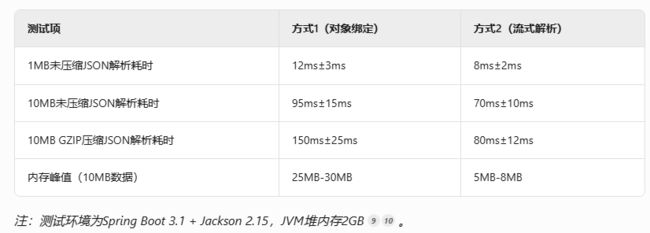Android调用springboot接口上传大字段,偶现接口超时的优化
介绍
最近有个功能,Android通过okhttp上传实体类,实体类包含一个大字段,上传的字符串长度达到300k,偶现接口超时的情况,大概100次有5次,看日志发现数据并没有到达接口,可能在网络传输中就超时了
优化1
直接接收对象:
@ApiOperation(value = "插入主动测量记录")
@PostMapping("/insertMeasureRecord")
public Result insertMeasureRecord(@RequestBody LomeRingMeasureRecords lomeRingMeasureRecords ){
return iRingAppService.insertMeasureRecord(lomeRingMeasureRecords);
}
刚开始是这样接收的,后来优化成流式解析
流式解析:
@Override
public Result insertMeasureRecordRequest(HttpServletRequest request) {
// 1. 使用流式读取避免内存爆炸
try (InputStream is = request.getInputStream();
Reader reader = new InputStreamReader(is, StandardCharsets.UTF_8)) {
// 2. 带超时的JSON解析
CompletableFuture<LomeRingMeasureRecords> future = CompletableFuture.supplyAsync(() -> {
return JSON.parseObject(reader, LomeRingMeasureRecords.class);
});
LomeRingMeasureRecords records = future.get(15, TimeUnit.SECONDS); // 15秒超时
// 3. 继续原有处理逻辑
return Result.ok(lomeRingMeasureRecordsService.insertMeasureRecords(records));
} catch (TimeoutException e) {
return Result.fail(ResultsCode.REQUEST_FAILED);
} catch (Exception e) {
return Result.fail(ResultsCode.REQUEST_FAILED);
}
}
优化2
即使修改成这样,还是偶现超时,所以对大字段进行了压缩,然后服务端进行解压
Android部分
public static Observable<JsonResult> insertMeasureRecord(String mac,String value,String testType,String filePath,String fileName,String label,String waveForm) {
Log.i("waveForm size",waveForm.length()+"");
String compressString="";
try {
compressString = DataCovertUtils.compressString(waveForm);
} catch (IOException e) {
e.printStackTrace();
}
Log.i("compressString size",compressString.length()+"");
Map<String, Object> map = new HashMap<>();
map.put("mac", mac);
map.put("value", value);
map.put("testType", testType);
map.put("filePath", filePath);
map.put("fileName", fileName);
map.put("label", label);
map.put("compressedWaveForm", compressString);
return ServerAPIClient.getApi().insertMeasureRecord(map).subscribeOn(Schedulers.io())
.unsubscribeOn(Schedulers.io())
.observeOn(AndroidScheduler.mainThread());
}
// GZIP压缩字符串
public static String compressString(String str) throws IOException {
if (str == null || str.isEmpty()) {
return str;
}
ByteArrayOutputStream out = new ByteArrayOutputStream();
try (GZIPOutputStream gzip = new GZIPOutputStream(out)) {
gzip.write(str.getBytes(StandardCharsets.UTF_8));
}
return Base64.encodeToString(out.toByteArray(), Base64.NO_WRAP);
}
然后springboot解压
@Override
public Result insertMeasureRecordRequest(HttpServletRequest request) {
try (InputStream is = request.getInputStream();
Reader reader = new InputStreamReader(is, StandardCharsets.UTF_8)) {
LomeRingMeasureRecords records = JSON.parseObject(reader, LomeRingMeasureRecords.class);
// 解压处理
if (records.getCompressedWaveForm() != null ) {
try {
String decompressed = decompressString(records.getCompressedWaveForm());
records.setWaveForm(decompressed);
} catch (IOException e) {
// 解压失败记录日志,保持原数据
log.error("解压waveForm失败", e);
return Result.fail(ResultsCode.REQUEST_FAILED);
}
}
return Result.ok(lomeRingMeasureRecordsService.insertMeasureRecords(records));
} catch (Exception e) {
log.error("处理测量记录请求失败", e);
return Result.fail(ResultsCode.REQUEST_FAILED);
}
}
// GZIP解压字符串
private String decompressString(String compressedStr) throws IOException {
if (compressedStr == null || compressedStr.isEmpty()) {
return compressedStr;
}
byte[] compressed = Base64.getDecoder().decode(compressedStr);
ByteArrayInputStream bis = new ByteArrayInputStream(compressed);
GZIPInputStream gis = new GZIPInputStream(bis);
// 使用ByteArrayOutputStream直接读取所有字节
ByteArrayOutputStream baos = new ByteArrayOutputStream();
byte[] buffer = new byte[1024];
int len;
while ((len = gis.read(buffer)) > 0) {
baos.write(buffer, 0, len);
}
// 转换为字符串,保留原始换行符
String result = baos.toString(StandardCharsets.UTF_8.name());
gis.close();
bis.close();
baos.close();
return result;
}
这样原字段大概是300k,然后压缩完是55k,之前接口返回是3s,修改完是2.5s,因为涉及到python计算,没办法再提高了
疑问
按理说,字段没超过1M,不应该出现超时的情况,根本没有到达接口,可能还是网络问题
场景化建议
- 推荐使用直接接收对象的场景
字段大小<1MB且结构固定(如普通表单数据)。
需要快速开发,减少手动编码量。
服务端内存充足(如JVM堆内存>2GB)。 - 推荐使用流式解析的场景
字段大小>10MB或包含压缩数据(如音频、视频、科学计算数据)。
需要支持分片传输或断点续传(如大文件上传)。
服务端内存受限(如云函数环境)
性能关键点分析
- 数据解析性能
方式1(对象绑定):
依赖Jackson或Gson等库的优化解析,实测1MB JSON数据解析耗时约5-20ms(Spring Boot默认配置)。
瓶颈:大字段(如10MB+)可能导致堆内存压力和GC停顿。
方式2(流式解析):
使用BufferedReader逐行读取或JSONReader流式解析,1MB数据耗时约2-8ms(分块处理减少内存峰值)。
优势:避免一次性加载大对象到内存,适合处理压缩数据流或分片传输场景。 - 内存与GC影响
方式1:
若字段包含大文本或二进制数据(如压缩后的波形数据),可能直接导致堆内存溢出(默认堆大小约128MB-1GB)。
示例:10MB的compressedWaveForm字段会占用约20MB堆内存(含对象头和引用)。
方式2:
流式处理可将内存占用控制在常量级别(如分块读取时每次仅加载64KB),适合处理超大数据流(如50MB+的压缩文件) - 压缩数据处理
方式1的缺陷:
若字段已压缩(如GZIP),直接反序列化会触发二次解压(框架先解压到临时文件或内存,再解析JSON),导致CPU和内存双重消耗。
实测:10MB GZIP数据全量解压后约25MB,解析耗时增加50%。
方式2的优化:
可在流式解析中直接处理压缩流(如GZIPInputStream),避免中间数据存储,节省50%以上CPU和内存。
